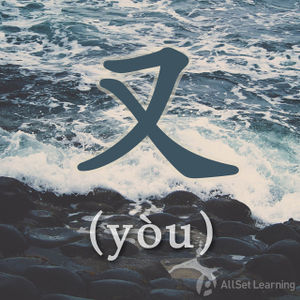Difference between revisions of "Expressing "both A and B" with "you""
| Line 25: | Line 25: | ||
* 你们 老板 <em>又</em> 年轻 <em>又</em> 有钱。<span class="pinyin">Nǐmen lǎobǎn <em>yòu</em> niánqīng <em>yòu</em> yǒu qián. </span><span class="trans">Your boss is both young and rich. </span> | * 你们 老板 <em>又</em> 年轻 <em>又</em> 有钱。<span class="pinyin">Nǐmen lǎobǎn <em>yòu</em> niánqīng <em>yòu</em> yǒu qián. </span><span class="trans">Your boss is both young and rich. </span> | ||
* 这里 的 咖啡 <em>又</em> 贵 <em>又</em> 难喝。<span class="pinyin">Zhèlǐ de kāfēi <em>yòu</em> guì <em>yòu</em> nánhē. </span><span class="trans">The coffee here is both expensive and bad-tasting. </span> | * 这里 的 咖啡 <em>又</em> 贵 <em>又</em> 难喝。<span class="pinyin">Zhèlǐ de kāfēi <em>yòu</em> guì <em>yòu</em> nánhē. </span><span class="trans">The coffee here is both expensive and bad-tasting. </span> | ||
| − | * | + | * 我家 小狗 <em>又</em> 可爱 <em>又</em> 听话。<span class="pinyin">Wǒjiā xiǎogǒu <em>yòu</em> kě'ài <em>yòu</em> tīnghuà. </span><span class="trans">My family's dog is both cute and obedient. </span> |
* 上海 的 冬天 <em>又</em> 冷 <em>又</em> 湿。<span class="pinyin"> Shànghǎi de dōngtiān <em>yòu</em> lěng <em>yòu</em> shī. </span><span class="trans">Winter here in Shanghai is both cold and humid. </span> | * 上海 的 冬天 <em>又</em> 冷 <em>又</em> 湿。<span class="pinyin"> Shànghǎi de dōngtiān <em>yòu</em> lěng <em>yòu</em> shī. </span><span class="trans">Winter here in Shanghai is both cold and humid. </span> | ||
* 她 小时候 <em>又</em> 矮 <em>又</em> 瘦。<span class="pinyin">Tā xiǎoshíhou <em>yòu</em> ǎi <em>yòu</em> shòu. </span><span class="trans">She was both short and thin when she was young. </span> | * 她 小时候 <em>又</em> 矮 <em>又</em> 瘦。<span class="pinyin">Tā xiǎoshíhou <em>yòu</em> ǎi <em>yòu</em> shòu. </span><span class="trans">She was both short and thin when she was young. </span> | ||
Revision as of 08:29, 11 November 2015
-
Level
-
Similar to
-
Used for
-
Keywords
In English, we often use descriptive words, and more than not, use multiple at a time. The character 又 (yòu) can be used to give two qualities or features to something. Using 又 (yòu) and the structure is like saying that something is "both ... and ... " in English.
Structure
The structure in Chinese is:
Subj. + 又 + Adj. 1 + 又 + Adj. 2
Unlike in English, the two words can't contrast in feeling. It is important to note they must both be bad or both be good.
Examples
- 她 男朋友 又 高 又 帅。Her boyfriend is both tall and handsome.
- 这 个 房子 又 大 又 亮。This house is both big and bright.
- 妈妈 的 头发 又 黑 又 亮。Mom's hair is both black and shiny.
- 我姐姐 又 聪明 又 漂亮。My elder sister is both smart and beautiful.
- 中国菜 又 便宜 又 好吃。Chinese food is both cheap and good-tasting.
- 你们 老板 又 年轻 又 有钱。Your boss is both young and rich.
- 这里 的 咖啡 又 贵 又 难喝。The coffee here is both expensive and bad-tasting.
- 我家 小狗 又 可爱 又 听话。My family's dog is both cute and obedient.
- 上海 的 冬天 又 冷 又 湿。Winter here in Shanghai is both cold and humid.
- 她 小时候 又 矮 又 瘦。She was both short and thin when she was young.



